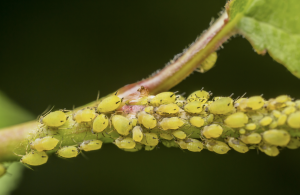Common brown scale (Coccidae and Diaspididae families)
These pest usually show up on the bottom leaves of the plant. They look shiny and are sticky. They look like brown nubs stuck to the wood y stem and underside of leaves, closest to the central vein.
y stem and underside of leaves, closest to the central vein.
What you can do:
1. Place a plastic bag or some covering around the soil of your plant. This prevents any scale from falling into your soil.
2. Get a natural, rosemary-based insecticidal soap. Spray this on the plant until the plant looks soapy.
3. Use an old toothbrush or even a toothpick along the stems and plant leaves, turning up the scale. You may see some scale fall onto the plastic bags; pick them up and discard them. Look over the entire plant. If helpful, get a pocket magnifier to look over the plant, including the creases of where the leaf meets the stem.
4. After the plant is sufficiently soaped and scraped, give it a good spray with your hose or your shower. You’ll want to get all the soap off the plant so it doesn’t affect growth. Keeping a plant strong, healthy and growing, can often keep insects at bay.
5. Check the plant again for the next three days, making sure that you hadn’t missed any scales. If you did, you can repeat steps 1-4. Check again once a week for the two months,
——
Aphids (Aphidoidea superfamily, Aphididae family)
Aphids may very well be the most commonly known unwanted houseplant pests.
What you can do:
The best way to get rid of aphids naturally is as follows: on a warm day, early in the morning take your infected houseplant outside and spray it vigorously with a hose. Be careful not to break the plant if it’s delicate or newly growing. This can be done by spraying short, strong bursts. This should knock down the aphid population naturally. Repeatedly do the hose-spray method for another few days until you see everything is under control.
——
Common whitefly (Trialeurodes vaporariorum)
At first whiteflies, which are more closely related to aphids and scale, can be mistaken for little white moths or even mealybugs. But these will take flight if you disturb them.
Adults will lay eggs while they are eating. Eggs will hatch in less than a week and then their nymphs will crawl a short distance, plant themselves, and suck the plant until they go into a resting stage at about the 3 week point. In about four, maybe five weeks, they begin to emerge as adults and the process repeats. As indicated, both the nymphs and adults of the whitefly use their mouthparts to suck juices from plants, which can cause leaves to yellow and fall off prematurely. Additionally, whiteflies, like aphids, exude a sticky dew, which becomes an attractant for mold. If you allow whiteflies to multiply, then they can attack your plant enough to weaken it.
What you can do:
Whiteflies are attracted to the color yellow, so the best way to catch them is by having yellow sticky traps, blasting the leaves with short bursts of water from a hose, and also introducing a beneficial insect, like a green lacewing, ladybird beetle, or whitefly parasite (Encarsia formosa). All three techniques are highly recommended, in that order.
Hope these DIY tips can help you have a hearty, strong houseplant that you can enjoy for months to come. Check out our other Bugyman Blog articles on other common pests and solutions.